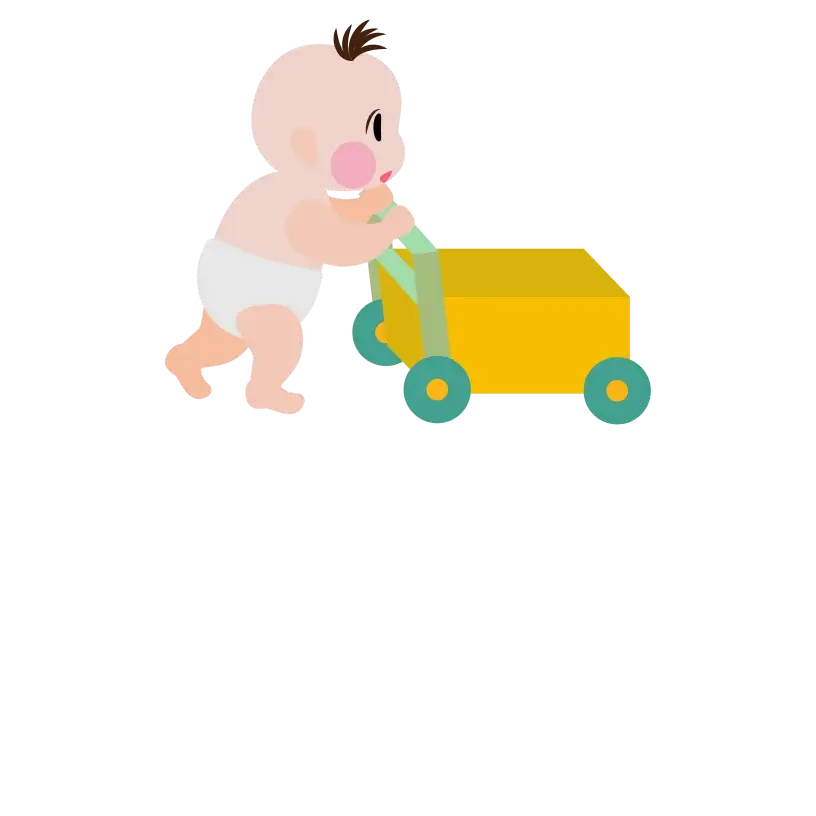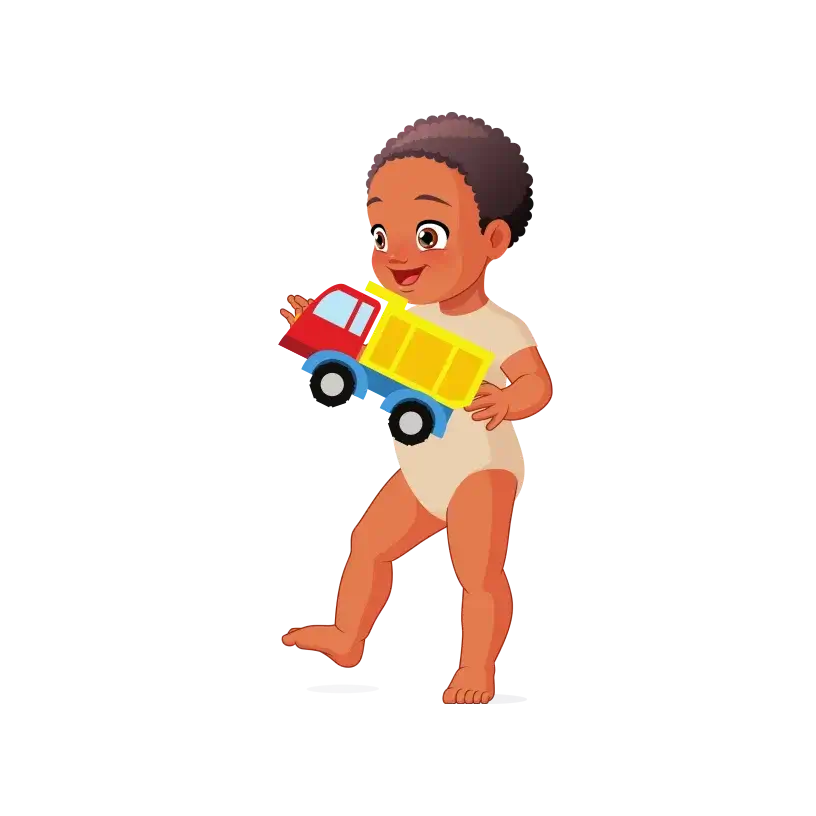Menu

Congratulations on reaching the official two-year mark with your little one!
As your little one turns two, it’s a time of challenges and joy. While tantrums may arise, there’s so much positive growth happening. Establishing daily routines and family rituals provides stability, creates lasting memories, and strengthens bonds. Embrace the milestones and cherish the special moments with your toddler as they explore this exciting stage of development.
As your baby reaches 24 months old, you may notice their confidence starting to blossom. This newly discovered confidence can manifest in their willingness to try new things and explore their surroundings more boldly. However, it can also lead them to test your boundaries as a parent as they assert their independence. It’s a natural part of their development as they learn to navigate the world around them and assert their preferences and desires.
According to the World Health Organization, the average weight for a 24-month-old is 26.5 pounds for girls and 27.5 pounds for boys. Additionally, the average height for a 24-month-old baby is 33.5 inches for girls and 34.8 inches for boys. Remember that every child grows at their own pace, so as long as they’re healthy and happy, there’s no need to worry too much about hitting exact averages.
Suppose your 24-month-old has a fever above 102°F (38.9°C) for more than one day with no other symptoms and has additional symptoms like a cold, cough, or diarrhoea. In that case, contacting the doctor sooner is a good idea, especially if these symptoms are severe. If the fever lasts more than three days, contact your healthcare provider.
Diarrhoea, when your child has loose or watery stools more than three times in a short period, can lead to dehydration if not treated. Vomiting, especially if it’s forceful or happens a lot after feedings, might also mean there’s an underlying issue that needs medical attention.
Dehydration is a serious concern, so watch for signs like fewer wet diapers, dry mouth, or reduced tears. If you notice these signs or your child’s soft spot on their head seems sunken, contact your healthcare provider immediately.
Constipation: If your child experiences fewer bowel movements than usual and appears to have been struggling or uncomfortable for several days, it’s essential to contact your healthcare provider.
Conversely, constipation can occur due to various factors such as viral infections, dietary changes, or antibiotic use. If your baby experiences frequent watery stools or shows signs of dehydration, consult a healthcare professional for guidance.
Lastly, while colds are usually mild and go away on their own, keep an eye out for symptoms like trouble breathing, ear pain, or a cough that won’t go away. If you notice any of these, getting medical advice promptly is important to ensure your child gets the care they need. Keeping an eye on your child’s health and staying in touch with your healthcare provider is key to keeping them safe and healthy.
Your child’s second birthday often marks the beginning of increased potty-training efforts. Signs that may indicate your child is ready for potty training include.
Research has shown that eighty-seven percent of kids have tantrums between 18 months and 24 months, and your child is not alone in experiencing this challenging phase. While it can be one of the more frustrating milestones at 24 months, it’s not always as terrible as it may seem.
Your child’s separation anxiety may intensify around this age as they become more aware of your absence. They may throw tantrums or cling to you when you try to leave. It’s important to remain calm and consistent and reassure them that you’ll return. Keep goodbyes short and sweet and provide specific details about when you’ll be back.
During your child’s upcoming 2-year-old checkup, the paediatrician will likely ask questions about your toddler’s behaviour to assess for signs of autism. However, if you have any concerns before then, don’t hesitate to discuss them with the doctor. Autism can be detected as early as 18 months, so early intervention is key.
Around this age, your child may start seeking your approval. They’ll become more aware of your reactions to their behaviour. It’s crucial to reinforce positive behaviours by expressing approval and praise when they behave well. Similarly, gently communicate disapproval when they misbehave, helping them learn appropriate behaviours.
Stay Consistent: Follow the rules and consequences you set. Empty threats undermine your authority, so issue only warnings you can follow through on—modeling good behaviour for your child.
Remove Temptations: Keep TVs, phones, and small items out of reach to prevent accidents. Store cleaning supplies and medicines safely away from children.
Use Distraction: Redirect your child’s attention away from unacceptable behaviour or dangerous objects. Avoid physical punishment, such as spanking, as it’s ineffective and sends the wrong message.
Implement Time-Out: Time-outs can be effective for discipline. Use a calm, neutral voice to explain why the behaviour is unacceptable and guide your child to a designated time-out area. Keep time-outs brief and ignore any pleas for attention until the child is calm.
Children between the ages of one and two should follow a meal pattern similar to adults, with three or four meals and two snacks daily. It’s important to offer a variety of foods from all food groups—vegetables, fruits, grains, protein, and dairy—daily to ensure they receive a balanced diet.
For snacks, choose healthy choices like fresh fruits, which provide vitamins, minerals, and fibre without added sugars or unhealthy fats. By offering diverse nutritious foods, you can help support your child’s health and well-being as they grow and explore new tastes and textures.
Consider transitioning your child from whole milk to 1 per cent or skim milk at two years old after consulting with your paediatrician. Additionally, incorporate low-fat dairy products like yoghurt and cheese into their diet. It’s important to ensure they receive enough calcium and vitamin D, with recommended daily intakes of 700 mg and 600 IU, respectively, for kids aged 1 to 3. Providing your 24-month-old with 16 oz of milk can help meet these nutritional needs.
At 24 months old, most toddlers require approximately 11 to 12 hours of sleep at night and a daytime nap lasting about 1.5 to 3 hours. This adds up to around 13 to 14 hours of sleep per day.
As your child ages, you may notice their afternoon nap becoming slightly shorter. However, maintaining their total daily sleep duration is important, so you might want to consider adjusting their bedtime earlier on days when their nap is shorter.

Between the ages of 1 and 2, your baby’s visual abilities undergo significant development. They become more adept at perceiving details and depth, which is essential for navigating their environment effectively.
By age 2, their vision is quite well-developed, allowing them to notice subtle nuances in their surroundings. As a parent, you can support this development by providing various visually stimulating experiences, such as colourful books, engaging toys, and outings to different places where they can encounter new sights and scenes.

Language comprehension continues to advance rapidly throughout the toddler years. By around 18 months, they can understand simple commands and recognise the names of familiar objects and people in their environment.
While their spoken vocabulary may still be limited, they communicate effectively through nonverbal means and enjoy engaging with auditory stimuli like music, stories, and conversations. Encouraging interactive and auditory-rich experiences can further enhance their language development and cognitive skills.

Their taste preferences and smell sensitivity evolve as your child grow. They begin to express preferences for certain flavours and may exhibit aversions to others. It’s common for them to reject new foods initially, but repeated exposure can gradually increase acceptance.
You can support this by offering diverse foods and encouraging descriptive discussions about tastes and smells during meals. This helps expand their palate and fosters language development and sensory awareness.

Your child’s sense of touch plays a crucial role in their cognitive and physical development. They use their hands to explore their environment, manipulate objects, and interact with people and surroundings.
While they may engage in hitting behaviours as a form of expression, teaching them appropriate ways to communicate and manage frustration is essential.
Providing a safe and stimulating environment for sense of touch, coupled with gentle guidance and positive reinforcement, helps your child develop fine motor skills, emotional regulation, and social skills.

Between the ages of 1 and 2, your baby’s visual abilities undergo significant development. They become more adept at perceiving details and depth, which is essential for navigating their environment effectively.
By age 2, their vision is quite well-developed, allowing them to notice subtle nuances in their surroundings. As a parent, you can support this development by providing various visually stimulating experiences, such as colourful books, engaging toys, and outings to different places where they can encounter new sights and scenes.

Language comprehension continues to advance rapidly throughout the toddler years. By around 18 months, they can understand simple commands and recognise the names of familiar objects and people in their environment.
While their spoken vocabulary may still be limited, they communicate effectively through nonverbal means and enjoy engaging with auditory stimuli like music, stories, and conversations. Encouraging interactive and auditory-rich experiences can further enhance their language development and cognitive skills.

Their taste preferences and smell sensitivity evolve as your child grow. They begin to express preferences for certain flavours and may exhibit aversions to others. It’s common for them to reject new foods initially, but repeated exposure can gradually increase acceptance.
You can support this by offering diverse foods and encouraging descriptive discussions about tastes and smells during meals. This helps expand their palate and fosters language development and sensory awareness.

Your child’s sense of touch plays a crucial role in their cognitive and physical development. They use their hands to explore their environment, manipulate objects, and interact with people and surroundings.
While they may engage in hitting behaviours as a form of expression, teaching them appropriate ways to communicate and manage frustration is essential.
Providing a safe and stimulating environment for sense of touch, coupled with gentle guidance and positive reinforcement, helps your child develop fine motor skills, emotional regulation, and social skills.
Losing interest in play: If your child suddenly loses interest in their favourite toys or activities, it could be a sign that they’re not feeling well. Illness or discomfort can drain their energy and make them less inclined to engage in play.
Eating or drinking less than usual: A decreased appetite or thirst may suggest that your child is feeling unwell. They may also have a sore throat, upset stomach, or other discomfort that makes eating or drinking less appealing.
Difficulty sleeping or napping: If your child is having trouble falling asleep or staying asleep, it could be due to discomfort from illness. For example, they may have a stuffy nose, sore throat, or earache, making sleeping difficult.
Crying more than usual: Increased crying could signify pain, discomfort, or frustration. Your child may be trying to communicate that they’re not feeling well or something is bothering them.
Wanting to be still or quiet: If your child is unusually still or quiet, it may indicate that they’re not feeling well and are trying to rest. They may be experiencing discomfort or fatigue and seeking relief by staying still and quiet.
Irritability and restlessness: If your child feels unwell, they may seem more irritable or restless than usual. They may be uncomfortable, in pain, or simply out of sorts.

At 24 months old, your child develops the coordination and strength to carry larger or multiple toys independently. This demonstrates improved gross motor skills and balance.

Your baby shouldRunning is a significant milestone that typically emerges around 24 months. Your child’s increased confidence in walking and improved balance allow them to start running short distances, further developing their gross motor skills. be able to sit upright with or without assistance. This helps ensure they can swallow food safely and reduces the risk of choking.

Your toddler’s cognitive skills are advancing, and they can now understand simple cause-and-effect relationships. This demonstrates their growing understanding of how objects interact with each other.

Language development progresses rapidly at 24 months. Your child is now starting to string together two to four words to form simple sentences, an exciting milestone in their communication skills.

Your child is becoming more aware of language patterns and is beginning to imitate words and phrases they hear in conversation. This is a natural part of language development as they expand their vocabulary and learn to communicate more effectively.

This milestone demonstrates your child’s growing understanding of object permanence and their ability to remember the location of hidden objects. It showcases their cognitive development and problem-solving skills.

While separation anxiety is common throughout early childhood, it often peaks around 24 months as your child becomes more aware of their attachment to caregivers and experiences anxiety when separated from them. This is a normal part of emotional development.

At 24 months old, your child develops the coordination and strength to carry larger or multiple toys independently. This demonstrates improved gross motor skills and balance.

Running is a significant milestone that typically emerges around 24 months. Your child’s increased confidence in walking and improved balance allow them to start running short distances, further developing their gross motor skills.

Your toddler’s cognitive skills are advancing, and they can now understand simple cause-and-effect relationships. This demonstrates their growing understanding of how objects interact with each other.

Language development progresses rapidly at 24 months. Your child is now starting to string together two to four words to form simple sentences, an exciting milestone in their communication skills.

Your child is becoming more aware of language patterns and is beginning to imitate words and phrases they hear in conversation. This is a natural part of language development as they expand their vocabulary and learn to communicate more effectively.

This milestone demonstrates your child’s growing understanding of object permanence and their ability to remember the location of hidden objects. It showcases their cognitive development and problem-solving skills.

While separation anxiety is common throughout early childhood, it often peaks around 24 months as your child becomes more aware of their attachment to caregivers and experiences anxiety when separated from them. This is a normal part of emotional development.
Engage in simple conversations with your toddler to help them develop language skills. Encourage clear speech and reply to their responses, creating opportunities for language development through interaction.
Encourage fine motor skills by engaging your 2-year-old in activities like folding paper, stacking blocks, or finger painting. These hands-on activities help them improve hand-eye coordination and dexterity.
Promote physical activity and active play to support your child’s overall development. Encourage running, jumping, and playing with balls to enhance their motor skills and physical fitness. Joining in the fun can make it even more enjoyable for your child.
Share stories with your child to stimulate their imagination and cognitive development. Whether recounting childhood memories or creating imaginative tales, storytelling helps them understand narrative structure and supports creativity. Use expressive tones, facial expressions, and gestures to make the storytelling experience engaging and memorable.
At 24 months old, your child can begin to grasp the emotions of those around them, which is a significant milestone. You may observe them comforting someone in distress or showing empathy towards others who are upset. Encourage this empathy by discussing emotions with your child and helping them express their feelings using words.
Encouraging confidence and security in your two-year-old promotes independence and good behaviour. By guiding them towards more mature behaviour and consistently setting reasonable boundaries, you help them understand what is acceptable while allowing room for exploration and curiosity. This approach helps them develop positive feelings and a sense of what is appropriate.
Consistency is key. Praise your child when they show positive behaviour, like playing nicely with others or completing tasks independently. This boosts their self-esteem and reinforces desired behaviour, leading to a positive self-image and a decrease in negative behaviours.
Every child is different, so there’s no rush to start potty training. Your toddler might be ready now, or they might not be interested yet, and that’s okay. Watch for signs that they’re thinking about it, like showing curiosity when you use the toilet or seeming bothered by wet or dirty diapers. Let your child lead the way, and when they seem ready, give potty training a try.
There’s no fixed age for transitioning your toddler from a cot to a bed, but most children do so before age three and a half. Moving your toddler to a big bed removes the concern of getting hurt if they attempt to climb out of the cot. If you’re unsure if your toddler is ready to climb out, consider placing pillows around the cot to ensure their safety during their initial attempts.
Don’t stress if your child refuses nutritious foods and sticks to white and brown options. Picky eating is common at 24 months and sometimes it’s their way to assert independence. Keep offering healthy choices, involve them in food selection and preparation, and demonstrate healthy eating habits. Eventually, they’ll be open to trying a variety of foods.
At 24 months old, your child can begin to grasp the emotions of those around them, which is a significant milestone. You may observe them comforting someone in distress or showing empathy towards others who are upset. Encourage this empathy by discussing emotions with your child and helping them express their feelings using words.
Encouraging confidence and security in your two-year-old promotes independence and good behaviour. By guiding them towards more mature behaviour and consistently setting reasonable boundaries, you help them understand what is acceptable while allowing room for exploration and curiosity. This approach helps them develop positive feelings and a sense of what is appropriate.
Consistency is key. Praise your child when they show positive behaviour, like playing nicely with others or completing tasks independently. This boosts their self-esteem and reinforces desired behaviour, leading to a positive self-image and a decrease in negative behaviours.
Every child is different, so there’s no rush to start potty training. Your toddler might be ready now, or they might not be interested yet, and that’s okay. Watch for signs that they’re thinking about it, like showing curiosity when you use the toilet or seeming bothered by wet or dirty diapers. Let your child lead the way, and when they seem ready, give potty training a try.
There’s no fixed age for transitioning your toddler from a cot to a bed, but most children do so before age three and a half. Moving your toddler to a big bed removes the concern of getting hurt if they attempt to climb out of the cot. If you’re unsure if your toddler is ready to climb out, consider placing pillows around the cot to ensure their safety during their initial attempts.
Don’t stress if your child refuses nutritious foods and sticks to white and brown options. Picky eating is common at 24 months and sometimes it’s their way to assert independence. Keep offering healthy choices, involve them in food selection and preparation, and demonstrate healthy eating habits. Eventually, they’ll be open to trying a variety of foods.
1. Center for Disease Control and Prevention: Birth to 24 months: Girls: Length-for-age and Weight-for-age percentiles
2. Center for Disease Control and Prevention: Birth to 24 months: Boys: Length-for-age and Weight-for-age percentiles
3. Children Minnesota: The Senses And Your 1-to 2-Year-Old
4. Healthy Children: How Pediatricians Screen for Autism
5. Healthy Children: Developmental Milestones: 2 Years Old
6. Healthy Children: Emotional Development: 2 Years Old
7. KidsHealth: Disciplining Your Toddler
8. KidsHealth: Nutrition guide for toddler
9. Mayo Clinic: Infant and Toddler Health
10. National Library of Medicine: Temper Tantrums
11. Riley Children’s Health: Growth and Development: 24-month
12. Sleep Foundation: How Much Sleep do Babies and Kids Need?
13. Unicef: Feeding your 1-2 years
© Mindsmaking 2024